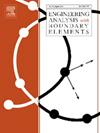伪弹性形状记忆合金拱梁的动态断通现象
IF 4.1
2区 工程技术
Q1 ENGINEERING, MULTIDISCIPLINARY
Engineering Analysis with Boundary Elements
Pub Date : 2025-10-06
DOI:10.1016/j.enganabound.2025.106487
引用次数: 0
摘要
本文首次考虑了形状记忆合金(SMA)的赝弹性效应(一种非线性材料),研究了形状记忆合金(SMA)拱梁的动态断通现象。为此,采用Lagoudas公式来模拟sma的伪弹性效应。采用Timoshenko梁理论对SMA拱梁进行建模。在假设von Karman非线性应变的前提下,推导了运动控制方程,并将其与sma的非线性相变方程耦合。为此,采用微分正交法(DQM)求解非线性控制方程,并采用Newmark法对非线性控制方程进行时域积分。同时,利用返回映射算法和Newton-Raphson技术克服了问题的非线性。本文采用Budiansky准则检测SMA拱梁的动屈曲载荷。在动屈曲荷载作用下,弹性材料制成的拱梁出现多次后续断裂。本研究中一个非常有趣的发现是,SMA材料的非线性或伪弹性效应阻止了SMA拱梁中后续的动态弹断现象,使得在第一次弹断现象发生后,系统的响应达到稳定状态。造成这一事实的原因是由于相变引起的能量耗散。对于不同几何参数下的钉-钉边界和固定-固定边界,给出了一些新的结果。本文章由计算机程序翻译,如有差异,请以英文原文为准。
Dynamic snap-through phenomena in pseudoelastic shape memory alloy arch-beams
This work deals with the dynamic snap-through phenomena in shape memory alloy (SMA) arch-beams taking into account the pseudoelastic effect of SMAs, a type of material nonlinearity, for the first time. For this aim, the Lagoudas formulation is used to model the pseudoelastic effect of SMAs. The SMA arch-beams are modeled employing the Timoshenko beam theory. By assuming the von Karman nonlinear strains, the governing equations of motion are derived while are coupled with the nonlinear phase transformation equations of SMAs. In this regard, the differential quadrature method (DQM) is employed to solve the nonlinear governing equations and the Newmark method is implemented to integrate these equations in the time domain. Meanwhile, the return mapping algorithm along with the Newton–Raphson technique is used to overcome the nonlinearities of the problem. In this work, the Budiansky criterion is employed to detect the dynamic buckling load of the SMA arch-beam. Under the dynamic buckling load, the arch-beams made of elastic materials exhibit multiple subsequent snap-throughs. A very interesting finding in this study is that, the material nonlinearity or pseudoelastic effect of SMAs prevents the subsequent dynamic snap-throughs in the SMA arch-beams, such that after the first snap phenomenon, the response of the system reaches a stable condition. The reason for this fact is the dissipation of energy due to the phase transformation in SMAs. In this regard, some novel results for pinned-pinned and fixed-fixed boundaries for different geometrical parameters have been presented.
求助全文
通过发布文献求助,成功后即可免费获取论文全文。
去求助
来源期刊

Engineering Analysis with Boundary Elements
工程技术-工程:综合
CiteScore
5.50
自引率
18.20%
发文量
368
审稿时长
56 days
期刊介绍:
This journal is specifically dedicated to the dissemination of the latest developments of new engineering analysis techniques using boundary elements and other mesh reduction methods.
Boundary element (BEM) and mesh reduction methods (MRM) are very active areas of research with the techniques being applied to solve increasingly complex problems. The journal stresses the importance of these applications as well as their computational aspects, reliability and robustness.
The main criteria for publication will be the originality of the work being reported, its potential usefulness and applications of the methods to new fields.
In addition to regular issues, the journal publishes a series of special issues dealing with specific areas of current research.
The journal has, for many years, provided a channel of communication between academics and industrial researchers working in mesh reduction methods
Fields Covered:
• Boundary Element Methods (BEM)
• Mesh Reduction Methods (MRM)
• Meshless Methods
• Integral Equations
• Applications of BEM/MRM in Engineering
• Numerical Methods related to BEM/MRM
• Computational Techniques
• Combination of Different Methods
• Advanced Formulations.
 求助内容:
求助内容: 应助结果提醒方式:
应助结果提醒方式:


